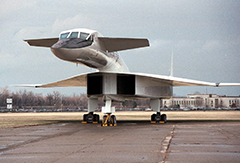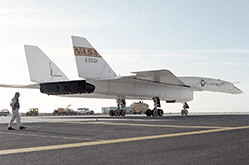XB-70 Valkyrie Bomber
The North American Aviation XB-70 Valkyrie was the prototype version of the planned B-70 nuclear-armed, deep-penetration strategic bomber for the United States Air Force Strategic Air Command. Designed in the late 1950s by North American Aviation (NAA), the six-engined Valkyrie was capable of cruising for thousands of miles at Mach 3+ while flying at 70,000 feet (21,000 m).
 At these speeds, it was expected that the B-70 would be almost immune to interceptor aircraft, the only effective weapon against bomber aircraft at the time. The bomber would spend only a few minutes over a particular radar station, flying out of its range before the controllers could position their fighters in a suitable location for an interception. High speed also made the aircraft difficult to see on radar displays and its high-altitude capacity could not be matched by any contemporary Soviet fighter.
At these speeds, it was expected that the B-70 would be almost immune to interceptor aircraft, the only effective weapon against bomber aircraft at the time. The bomber would spend only a few minutes over a particular radar station, flying out of its range before the controllers could position their fighters in a suitable location for an interception. High speed also made the aircraft difficult to see on radar displays and its high-altitude capacity could not be matched by any contemporary Soviet fighter.
The introduction of the first Soviet surface-to-air missiles in the late 1950s put the near-invulnerability of the B-70 in doubt. In response, the United States Air Force (USAF) began flying its missions at low level, where the missile radar's line of sight was limited by terrain. In this low-level penetration role, the B-70 offered little additional performance over the B-52 it was meant to replace, while being far more expensive with shorter range. Other alternate missions were proposed, but these were of limited scope. With the advent of intercontinental ballistic missiles (ICBMs) during the late 1950s, manned bombers were increasingly seen as obsolete.
The USAF eventually gave up fighting for its production and the B-70 program was canceled in 1961. Development was then turned over to a research program to study the effects of long-duration high-speed flight. As such, two prototype aircraft, designated XB-70A, were built; these aircraft were used for supersonic test-flights during 1964–69. In 1966, one prototype crashed after colliding with a smaller aircraft while flying in close formation; the remaining Valkyrie bomber is in the National Museum of the United States Air Force near Dayton, Ohio.
 The Valkyrie was designed to be a high-altitude Mach 3 bomber with six engines. Harrison Storms shaped the aircraft with a canard surface and a delta wing, which was built largely of stainless steel, sandwiched honeycomb panels, and titanium. The XB-70 was designed to use supersonic technologies developed for the Mach 3 SM-64 Navaho, as well as a modified form of the Navaho's inertial guidance system.
The Valkyrie was designed to be a high-altitude Mach 3 bomber with six engines. Harrison Storms shaped the aircraft with a canard surface and a delta wing, which was built largely of stainless steel, sandwiched honeycomb panels, and titanium. The XB-70 was designed to use supersonic technologies developed for the Mach 3 SM-64 Navaho, as well as a modified form of the Navaho's inertial guidance system.
The XB-70 used compression lift, which arose from a shock wave generated by the sharp leading edge of the central engine intake splitter plate below the wing. At Mach 3 cruising speed, the shock wave attached along the wing leading edge, preventing the high pressure behind the shock front from leaking up over the wing. The compression lift provided five percent of the total lift. The wing included inboard camber to more effectively use the higher pressure field behind the strong shock wave. Unique among aircraft of its size, the outer portions of the wings were hinged, and could be pivoted downward by up to 65 degrees, acting almost as a type of variable-geometry wingtip device. This increased the aircraft's directional stability at supersonic speeds, shifted the center of lift to a more favorable position at high speeds, and strengthened the compression lift effect. With the wingtips drooped downwards, the compression lift shock wave would be further trapped under the wings. More details
 At these speeds, it was expected that the B-70 would be almost immune to interceptor aircraft, the only effective weapon against bomber aircraft at the time. The bomber would spend only a few minutes over a particular radar station, flying out of its range before the controllers could position their fighters in a suitable location for an interception. High speed also made the aircraft difficult to see on radar displays and its high-altitude capacity could not be matched by any contemporary Soviet fighter.
At these speeds, it was expected that the B-70 would be almost immune to interceptor aircraft, the only effective weapon against bomber aircraft at the time. The bomber would spend only a few minutes over a particular radar station, flying out of its range before the controllers could position their fighters in a suitable location for an interception. High speed also made the aircraft difficult to see on radar displays and its high-altitude capacity could not be matched by any contemporary Soviet fighter.The introduction of the first Soviet surface-to-air missiles in the late 1950s put the near-invulnerability of the B-70 in doubt. In response, the United States Air Force (USAF) began flying its missions at low level, where the missile radar's line of sight was limited by terrain. In this low-level penetration role, the B-70 offered little additional performance over the B-52 it was meant to replace, while being far more expensive with shorter range. Other alternate missions were proposed, but these were of limited scope. With the advent of intercontinental ballistic missiles (ICBMs) during the late 1950s, manned bombers were increasingly seen as obsolete.
The USAF eventually gave up fighting for its production and the B-70 program was canceled in 1961. Development was then turned over to a research program to study the effects of long-duration high-speed flight. As such, two prototype aircraft, designated XB-70A, were built; these aircraft were used for supersonic test-flights during 1964–69. In 1966, one prototype crashed after colliding with a smaller aircraft while flying in close formation; the remaining Valkyrie bomber is in the National Museum of the United States Air Force near Dayton, Ohio.
 The Valkyrie was designed to be a high-altitude Mach 3 bomber with six engines. Harrison Storms shaped the aircraft with a canard surface and a delta wing, which was built largely of stainless steel, sandwiched honeycomb panels, and titanium. The XB-70 was designed to use supersonic technologies developed for the Mach 3 SM-64 Navaho, as well as a modified form of the Navaho's inertial guidance system.
The Valkyrie was designed to be a high-altitude Mach 3 bomber with six engines. Harrison Storms shaped the aircraft with a canard surface and a delta wing, which was built largely of stainless steel, sandwiched honeycomb panels, and titanium. The XB-70 was designed to use supersonic technologies developed for the Mach 3 SM-64 Navaho, as well as a modified form of the Navaho's inertial guidance system.The XB-70 used compression lift, which arose from a shock wave generated by the sharp leading edge of the central engine intake splitter plate below the wing. At Mach 3 cruising speed, the shock wave attached along the wing leading edge, preventing the high pressure behind the shock front from leaking up over the wing. The compression lift provided five percent of the total lift. The wing included inboard camber to more effectively use the higher pressure field behind the strong shock wave. Unique among aircraft of its size, the outer portions of the wings were hinged, and could be pivoted downward by up to 65 degrees, acting almost as a type of variable-geometry wingtip device. This increased the aircraft's directional stability at supersonic speeds, shifted the center of lift to a more favorable position at high speeds, and strengthened the compression lift effect. With the wingtips drooped downwards, the compression lift shock wave would be further trapped under the wings. More details
